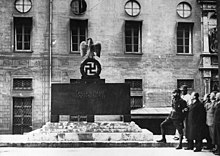Slackers Alley
Drückebergergasse (also Drückeberger -Gassl) is the popular name for the narrow, cobblestone-paved Viscardigasse in Munich. It is officially named after the Swiss baroque master builder Giovanni Antonio Viscardi . The alley is only open to pedestrians, there are no curbs on either side .
location
The alley, a little over fifty meters long, is located at the northern end of the pedestrian zone in the historic core of Munich city center. It connects Residenzstrasse and Theatinerstrasse shortly before they flow into Odeonsplatz on the east and west side of the Feldherrnhalle .
Origin of the name

On November 9, 1923, in front of the Feldherrnhalle, Hitler's attempted coup , which was supposed to bring the Weimar Republic down, failed . 16 of the putschists (“ martyrs of the movement ”) and four police officers were killed. The Feldherrnhalle subsequently became a National Socialist consecration site. In 1933 a memorial with the names of the putschists who had been killed and the inscription "And you have won" was erected on the east side of the street facing Residenzstrasse; from then on, marches and swearing-in took place. Before the memorial was during the Third Reich day and night SS - guard of honor ( "dual posts"). At this point, all passers-by were expected to pay tribute in the form of a Hitler salute. If you didn't want to do that, you could avoid this section of Residenzstraße by making a detour through the small Viscardigasse and Theatinerstraße west of the Feldherrnhalle. In allusion to this, the citizens of Munich called the narrow lane at the back of the Feldherrnhalle as Drückebergergassl .
After the Second World War

After the invasion of the Americans, the 7th US Army had the National Socialist Memorial dismantled and melted down on May 3, 1945. The Drückebergergasse is often called that in a historical context - for city tours, visits by foreigners or “city history walks”, to illustrate the quiet, civil resistance of the residents of the Bavarian capital against the National Socialist regime. To commemorate this, an S-shaped, curved, approximately 30 cm wide bronze track (title: Arguments ) designed by the sculptor and bronze caster Bruno Wank was embedded in the cobblestones of Viscardigasse along the “detour” that some took at the time . The trail was created by Wank replacing existing paving stones with untreated bronze cubes, which over time were given a shiny surface by passers-by.
Cultural reception
The principle of Drückebergergasse can already be found in 1804 by Friedrich Schiller . In his play Wilhelm Tell , the Reichsvogt demands that the Swiss pay tribute in front of a symbolically hung hat. Two soldiers stand guard in front of it and talk:
“We watch out for free. Nobody wants to give themselves
up and show their hats' reverence
. It was usually like a fair here,
Now the whole area is deserted,
Since the bogey hangs on the pole.
(...)
What real people are, they prefer to make
the long detour around half a spot,
before they bow their backs to their hats. "
In Alfred Andersch's autobiographical story The Islands under the Wind , the possibility of bypassing the guard via the small alley is mentioned.
Individual evidence
- ↑ Gassl = Gässchen (narrow, paved path between two houses).
- ↑ Hans Maier : Collected writings. Volume 2: Political Religions. C. H. Beck, Munich 2007, ISBN 978-3-406-56216-7 , p. 111.
- ↑ Helga Pfoertner: Living with history. Memorials, memorials, places of remembrance for the victims of National Socialism in Munich 1933–1945. Volume 1: A to H. Literareron in Utz-Verlag, Munich 2001, ISBN 3-89675-859-4 , p. 26 ( PDF; 1.1 MB ( Memento from April 28, 2014 in the Internet Archive )).
- ↑ MONACO - Discover Munich with all your senses. Special publication of the Süddeutsche Zeitung, October 26, 2019, p. 10.
- ↑ Friedrich Schiller: Complete works: The bride of Messina. William Tell. (...) . Editor of the volume: Matthias Oehme. In: Hans-Günther Thalheim and a collective of employees (ed.): All works in ten volumes. Berlin edition . 1st edition. tape 5.1 . Aufbau-Verlag, Berlin / Weimar 1990, ISBN 3-351-01153-9 , p. 156-157 . - Friedrich Schiller: Dramas II . Edited with critical text by Herbert Kraft (...). In: Schiller's works . Edition 1982. Volume 2 . Insel-Verlag, Frankfurt am Main 1966, DNB 820598011 , p. 388 .
Web links
Coordinates: 48 ° 8 ′ 29 ″ N , 11 ° 34 ′ 38 ″ E
